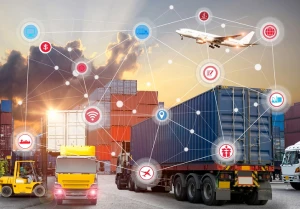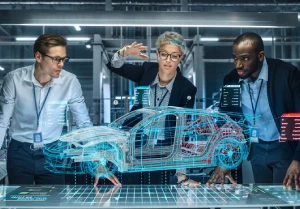Digital transformation in the renewable energy industry has yielded valuable insights, helping organizations enhance efficiency, sustainability, and resilience. As renewable energy systems become more interconnected and data-driven, several important lessons have emerged from the sector’s digitalization journey. Here are the key lessons learned:
- Data Integration is Critical for Optimizing Performance
- Lesson: Successful digital transformation in renewable energy depends on collecting, analyzing, and integrating data from diverse sources such as wind turbines, solar panels, grid systems, and weather forecasts.
- Challenge: Many renewable energy projects initially struggled with fragmented data systems, leading to inefficiencies and suboptimal decision-making.
- Takeaway: Centralized data platforms that integrate inputs from multiple sources allow for real-time optimization of energy generation, storage, and distribution, improving overall efficiency.
- AI and Machine Learning Enhance Forecasting and Decision-Making
- Lesson: AI and machine learning can significantly improve the accuracy of weather and energy demand forecasting, optimizing the performance of renewable energy assets.
- Challenge: Early implementations faced difficulties with inaccurate forecasts and underutilized data.
- Takeaway: Machine learning models, when trained with large and high-quality datasets, can optimize power output, improve energy trading strategies, and enhance grid reliability by better predicting fluctuations in supply and demand.
- Predictive Maintenance Increases Asset Lifespan and Reduces Downtime
- Lesson: IoT sensors and predictive analytics enable renewable energy operators to monitor equipment in real-time, predicting failures before they occur and minimizing downtime.
- Challenge: Some companies underestimated the complexity of deploying predictive maintenance systems and initially encountered issues with data integration and sensor accuracy.
- Takeaway: Proper implementation of predictive maintenance systems leads to significant cost savings by reducing equipment failure, prolonging asset life, and minimizing disruptions in energy production.
- Digitalization Enhances Grid Stability and Flexibility
- Lesson: Digital transformation is crucial for managing the intermittency of renewable energy sources (e.g., solar and wind). Smart grids and digital energy management systems help balance supply and demand in real-time.
- Challenge: The transition from traditional grids to smart grids faced hurdles such as outdated infrastructure and regulatory barriers.
- Takeaway: Smart grids, combined with real-time data, demand response technologies, and energy storage solutions, are essential for maintaining grid stability and integrating renewable energy into national grids.
- Cybersecurity is Essential as Digital Complexity Increases
- Lesson: With the rise of interconnected energy systems and smart devices, cybersecurity has become a major concern. Renewable energy infrastructure is now a target for cyberattacks.
- Challenge: The renewable energy sector was initially slower to adopt robust cybersecurity protocols, leaving systems vulnerable.
- Takeaway: A proactive approach to cybersecurity is necessary, including regular security audits, advanced encryption methods, and monitoring of both physical and digital assets to protect critical infrastructure from attacks.
- Energy Storage Solutions Need to be Digitally Integrated
- Lesson: As renewable energy production fluctuates with weather conditions, energy storage systems such as batteries and pumped storage need to be digitally integrated to ensure seamless energy supply during off-peak production periods.
- Challenge: Early storage systems often operated independently, leading to inefficiencies and underutilization of stored energy.
- Takeaway: Integrating energy storage systems with advanced energy management platforms allows for better energy dispatching and maximizes the use of renewable energy, improving grid resilience.
- Customer-Centric Models are Growing
- Lesson: Digital platforms allow energy companies to adopt customer-centric models, providing consumers with real-time data on their energy usage, offering personalized energy plans, and enabling peer-to-peer energy trading.
- Challenge: Historically, the energy industry was more focused on large-scale generation than on individual consumer needs, which limited the adoption of customer-centric innovations.
- Takeaway: Offering consumers transparency and control over their energy usage through apps and dashboards has become a differentiator, enabling new business models like decentralized energy production, where consumers can sell excess energy back to the grid.
- Automation and AI Improve Operational Efficiency
- Lesson: Automation, such as AI-driven control systems and autonomous monitoring technologies, has improved operational efficiency, reduced human error, and allowed for better management of large renewable energy assets.
- Challenge: Early adopters struggled with the integration of automation systems, leading to inefficiencies and concerns over job displacement.
- Takeaway: Gradual adoption of automation, with clear roles for human oversight, helps maximize the potential of AI tools while maintaining operational integrity and boosting efficiency across the renewable energy lifecycle.
- Blockchain Enhances Transparency and Security in Energy Trading
- Lesson: Blockchain technology offers transparency, security, and efficiency in renewable energy trading, enabling peer-to-peer energy exchanges and improving tracking of renewable energy certificates (RECs).
- Challenge: The implementation of blockchain in energy trading faced scalability and regulatory hurdles, particularly in large markets.
- Takeaway: Blockchain solutions can create more secure, transparent, and efficient energy markets, promoting decentralized energy distribution and enhancing trust in energy trading processes.
- Leadership and Cultural Alignment are Vital
- Lesson: Successful digital transformation requires leadership commitment and a culture that embraces change. Digital transformation in the renewable energy sector often failed when companies didn’t align their organizational culture with the goals of digitalization.
- Challenge: Resistance to change, especially from older workforce segments or entrenched stakeholders, slowed digital adoption in some companies.
- Takeaway: Leadership must clearly communicate the strategic importance of digital initiatives, foster an innovative mindset, and provide continuous training to align the workforce with the company’s digital transformation goals.
- Scalable Solutions are Key to Meeting Growing Energy Demands
- Lesson: Digital tools must be scalable to meet the growing global demand for renewable energy. Systems designed for small-scale operations can struggle when expanded to larger grids or multinational energy networks.
- Challenge: Many early digital solutions weren’t scalable, leading to bottlenecks in data processing and decision-making as operations expanded.
- Takeaway: Scalable platforms, designed with flexibility and expansion in mind, ensure that renewable energy operators can meet both current and future energy needs efficiently.
- Collaboration Across the Energy Ecosystem is Essential
- Lesson: Collaboration between stakeholders—including energy producers, grid operators, regulators, and technology providers—is crucial for effective digital transformation in renewable energy.
- Challenge: A lack of coordination between various stakeholders can lead to inefficiencies, project delays, or misaligned goals.
- Takeaway: Fostering collaboration and building partnerships across the ecosystem accelerates digital innovation, allowing for faster deployment of digital solutions and smoother integration into existing energy infrastructure.
Summary of Key Lessons:
- Data integration and real-time analytics are essential for optimizing performance and ensuring efficient energy generation and storage.
- AI and machine learning improve forecasting accuracy and decision-making in renewable energy operations.
- Predictive maintenance reduces downtime and extends the lifespan of renewable energy assets.
- Smart grids and digital energy management systems are crucial for managing renewable energy intermittency and ensuring grid stability.
- Cybersecurity needs to be prioritized as renewable energy systems become increasingly digitized and interconnected.
- Energy storage integration with digital platforms enhances the reliability of renewable energy supply.
- Customer-centric models, enabled by digital platforms, are becoming more prevalent in the industry.
- Automation and AI improve operational efficiency, but gradual implementation and clear human oversight are essential.
- Blockchain technology offers transparency and security in energy trading, enabling decentralized energy markets.
- Leadership commitment and cultural alignment are key to driving successful digital transformation.
- Scalable digital solutions are essential for meeting growing energy demands and expanding operations.
- Collaboration across the energy ecosystem is necessary for integrating digital technologies and scaling renewable energy projects.
Digital transformation in the renewable energy industry enables organizations to optimize resources, reduce costs, and better manage the transition to a sustainable energy future. With the right strategies, tools, and collaboration, the industry can continue to expand its role in the global energy mix.





